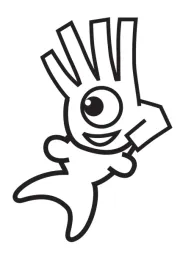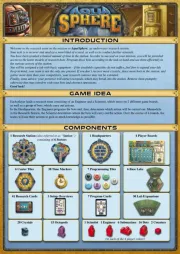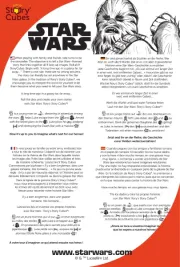Amigo No Thanks! Handleiding
Bekijk gratis de handleiding van Amigo No Thanks! (4 pagina’s), behorend tot de categorie Bordspel. Deze gids werd als nuttig beoordeeld door 20 mensen en kreeg gemiddeld 3.6 sterren uit 10.5 reviews. Heb je een vraag over Amigo No Thanks! of wil je andere gebruikers van dit product iets vragen? Stel een vraag
Pagina 1/4

AGES
8+ MINUTES
20
PLAYERS
3-7
The Play or Pay
Card Game
™
1
Invented by THORSTEN GIMMLER
If you’d prefer to learn to play by watching a short video,
please visit www.amigo.games/game/nothanks.
INSTRUCTIONS
To score the fewest points; players score points each time they collect a
card and subtract points for each counter they hold at the end of the game.
Although this game is designed for ages 8 and up, the components listed in red are a choking
hazard. Please take special care to keep these components away from young children.
Shuffle the cards thoroughly and put nine cards back into the box
without looking at them. These cards will not be used.
Place the rest of the cards, face-down, to form a stack.
Give a supply of counters to each player, based on the number of
people playing. For - players, give counters; for players, give
counters; and for players, give counters. Return any remaining
counters to the box.
• Counters• Cards, numbered from -
CONTENTS
SET UP
OBJECT OF THE GAME

2
GAME PLAY
If you’re the oldest player, you start play by:
a. Flipping over the top card from the stack and deciding if you will:
i. Take the card and put it face-up in front of you (this means that
you collect the points on the card), or
ii. Say, “No Thanks!” and put a counter from your supply of
counters onto the card so you don’t have to take it.
Each card is worth the number of points shown on the card (but
remember, points are bad!). Counters are good – each one cancels out
one point from a card at the end of the game.
If you don’t take the card, the player on your left must make the same
choice: take the card or put a counter onto it. This continues until a
player takes the card, and all of the counters on it. Sometimes (typically
with cards that have high numbers), play will go around and around –
you’ll get multiple chances to put a counter onto the card before you or
someone else takes it. When you take a card, put it face-up in front of you
on the table and add the counters on the card to your supply of counters.
Every time you take a card, re-start play by flipping over the top card from
the stack. You can then either take that card or put a counter onto it. If
you keep taking cards, your turn continues and you flip over additional
cards. As soon as you put a counter onto a card instead of taking it, play
passes to the player on your left to decide whether to take the card or put
a counter onto it.
HINT: It’s a good idea to keep your counters hidden. Most people
hold them in their closed fists, but anywhere you hide them will work.
For example, Eli flips over the 11 and decides that he doesn’t
want it. He puts a counter onto it and says, “No Thanks!”
Play passes to Alani (who is sitting on his left).

3
Alani doesn’t want it either, so she puts a counter onto it
and play passes to Sherry.
Sherry says, “No Thanks!” and puts a counter
onto the card.
It’s now Eli’s turn again. Eli decides to take the card. He puts it
face-up in front of himself, adds the three counters on it to the
counters in his hand, and flips over the top card on the stack.
When you don’t have any counters left, you must take the card.
If you take cards with consecutive numbers, only the lowest number
in the series will count against you. A series can be made up of as
few as two cards. When you collect cards that form a series, place
them face-up so that they overlap, but so that players can still see the
numbers in the corners of the cards.
WINNING THE GAME
The game ends when the stack is gone and there are no cards left to
collect. Add up the points on all the cards you took (only count the
lowest card in a series), then subtract the number of counters you have.
The player with the lowest total wins. In this example, you have
taken cards worth 3+7+
12+15+25, for a total of
62 points. Subtract your
8 counters, and your final
score is 54 points.
For example, if you take the 13, 15,
and 16, you will only count the 13
and the 15 when it’s time to score
(since the 15 is the lowest number
in the 15-16 series), for a total of 28 points. If you later collect the 14, you will only count the
13 (since it’s the lowest in the 13-14-15-16 series).
+=28 =13
+++
+
Product specificaties
| Merk: | Amigo |
| Categorie: | Bordspel |
| Model: | No Thanks! |
| Kleur van het product: | Meerkleurig |
| Aanbevolen leeftijd (min): | 8 jaar |
| Voorgesteld geslacht: | Elk geslacht |
| Aanbevolen leeftijdscategorie: | Volwassene & kind |
| Minimum aantal spelers: | 3 |
| Type product: | Bordspel |
| Leer- en opleidingsvaardigheden: | Critical thinking training, Logical thinking training, Fine motor skills training |
| Aantal kaarten: | 33 stuk(s) |
| Speeltijd (max): | 20 min |
| Maximum aantal spelers: | 7 |
| Genre: | Familie |
| Spelmodi: | Multiplayer |
| Familiespel: | Ja |
| Game-editie: | Reiseditie |
| Naam game: | No Thanks! |
Heb je hulp nodig?
Als je hulp nodig hebt met Amigo No Thanks! stel dan hieronder een vraag en andere gebruikers zullen je antwoorden
Handleiding Bordspel Amigo

4 Juli 2023

2 Juli 2023

2 Juli 2023

1 Juli 2023

29 Juni 2023

26 Juni 2023

24 Juni 2023

23 Juni 2023

23 Juni 2023

22 Juni 2023
Handleiding Bordspel
- Pegasus
- White Goblin Games
- Reisspellen
- Gamewright
- USAopoly
- Gezelschapsspellen
- Zoch
- Blue Orange
- MB
- 999Games
- King
- Kogan
- MindWare
- Jumbo
- Hudora
Nieuwste handleidingen voor Bordspel

3 Juli 2025

1 Juli 2025

30 Juni 2025

19 April 2025

19 April 2025

19 April 2025

19 April 2025

19 April 2025

6 April 2025
